
Contact

Home
Loch Ness Monster part 13

1934

continued
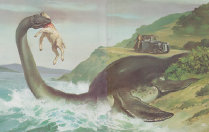
Contents
ANOTHER LEGEND?
LOCH NESS MONSTER.
The Northern Miner (Charters Towers, Qld.)
Date: May 9, 1934
Page Number: 1
From the earliest times the Scottish Highlands have been a region of mystery and legend, an effect ascribed to the somewhat mystical and highly poetical mentality of the inhabitants. They saw—and it is rumoured, still see—things not visible to ordinary mortal eyes; "second sight" was a recognised and fairly frequent phenomenon, and the woods and hills around them were the haunt of fairies and elves, says an exchange.
In recent years, however, the Highlands have been "opened up;" railways run along the glens and great highways cross the mountains. Prosaic Anglo-Saxon eyes have viewed these hills and lochs, these glens and moors, and have seen their beauty, but no more. Highlanders still have their songs and their poetry, but their
country is no longer unknown land, and becoming known, has emerged from the mists of legend and fairytale. Or so it was thought until the autumn of 1933.
About that time paragraphs began to appear about something strange in Loch Ness. Local inhabitants had
seen something large and alive in the water, where normally nothing bigger than a salmon lives and moves. It
was seen again and again.
The newspaper paragraphs grew longer and the headlines bigger. Papers of other countries took up the
tale, and soon the whole world was reading of "the Loch Ness Monster." Reporters and photographers began to haunt the shores of the loch, and learned professors gave their opinions as to what this strange visitor might be.
Meanwhile, its lusty splashings continued to disturb the tranquil waters of Loch Ness until quite a large number of people had been vouchsafed a glimpse of it, without, however, making it possible to offer any explanation of what it was, or how it got there.
That is the position to-day. Few, now doubt that there is something in Loch Ness, but the theories as to what it is are numerous and contradictory. There is the giant eel school of thought, closely allied to the newt theory. Others say it is only a seal, or even a walrus. Believers in the sea-serpent are happily saying "I told you so!" But perhaps the most pleasing theory of all is that this is some reptilian survivor from prehistoric times has lived in the depths of Loch Ness for thousands of years, and has only now come to the surface, disturbed by blasting operations in connection with the reconstruction of the road along the loch-side.
How many of the ancient Highland legends have to do with kelpies, strange water-beasts, the presence of which struck terror into whole neighbourhoods. Tales of them have usually been ascribed to the vivid imagination of uneducated people living in wild and lonely, sometimes eerie surroundings. But here we have something happening in Loch Ness in 1933, and in 1934, too, and the people who, have seen the "monster" are educated people, in regular contact with the outside world. May not the old kelpie stories spring from a similar cause, and were the Highlanders of old as superstitious as the world has been led to believe?
In any case, this summer, when the holiday season comes round, it is certain that many thousands will flock to the Loch Ness district, and even if they see no "monster" they will not go in vain. Loch Ness, with or without monsters, is worth going a way to see.

Free Show.
Goulburn Evening Penny Post (NSW)
Date: May 9, 1934
Page Number: 2
They say that at least 200 persons in Scotland claim to have seen the monster believed to reside in Loch Ness. This is probably because there is no charge for seeing it .

New Fashions
The Land (Sydney, NSW)
Date: May 11, 1934
Page Number: 16
New fashions come every day, whether it be in women's clothing or motor cars. Even monsters have their day. Scotland has brought into prominence the mysterious monster of Loch Ness. Italy, not to be outdone, has a hornless bull as big as an elephant lurking in the hills of Tuscany, and a snorting, fire-spitting dragon plouging the waters of Lake Maggiore. There have been no reports to hand of any being found in Australia, but there are reports, from time to time, of Bunyips and prowling unknown animals. Some of these, however, have been in the same category as the green snakes that issue from the empty metho bottles.

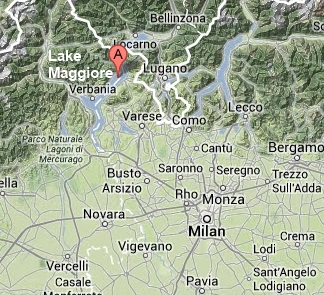
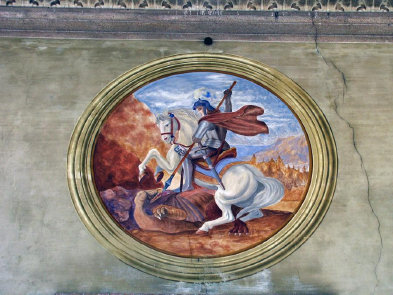
The dragon in the church of Cannero, Lake Maggiore, Piedmont, Italy.
SEA SERPENTS.
Or Perhaps Giant Cuttle Fish.
By David G. Stead
The Land (Sydney, NSW)
Date: May 11, 1934
Page Number: 16
...
As regards the "Loch Ness monster," from the very varied accounts that have been published, this does truly appear to belong to the type of sea monster very often seen by Scotchmen—but not always when they were beside the sea! To be serious though, it has been a fond hope of many that some extinct plesiosaurus or ichthyosaurus may have lived down through the ages to exhibit itself to our modern gaze but to me nothing appears more unlikely. Bear in mind that they were both air-breathing animals which could not hide away indefinitely in the depths of the sea.

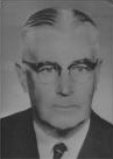
David George Stead
(6 March 1877 – 2 August 1957) was an Australian marine biologist, ichthyologist, oceanographer, conservationist and writer.


THAT ELUSIVE MONSTER.
The Sydney Morning Herald (NSW)
Date: May 21, 1934
Page Number: 8
The Loch Ness monster, in which few Londoners still believe, is a diligent and obliging creature. True, it has not been "seen" during the past week or two, but everybody admits that it did the right thing by appearing during the Easter holidays. Hundreds of excursionists, with nothing better to do, went up to Loch Ness on the off chance of catching a glimpse of the faithful thing, and two of them—a hockey player and a chemist—did not make the trip in vain. The monster revealed itself to them separately, at different times and places, but so eluslveiy that neither of the spectators could afterwards describe it. That, of course, was unfortunate, for the augmented holiday crowd, in a mood of carping jealousy, professed to be sceptical. It certainly seemed to be unfair that out of a very numerous and well-disposed contingent only two should have been privileged to find the monster at home. On the other hand, the really important point is that the monster was willing to be seen at all. He has been such an asset to the locality—such a stimulator of trade and hotel patronage—that only the very hard-hearted could have expected more than a brief appearance at a time when the whole world was on holiday. Even monsters must rest.
Seriously, though, the Loch Ness monster has ceased to be a newspaper sensation, and is rapidly degenerating into a bore. Much money and time have been expended in trying to label him, but not a single member of any expedition by air, land, or sea has been able to supply even the nucleus of a description. The handful of people who vow that they have seen him "with their own eyes" have been equally at a loss for details, in consequence, the situation has become so provoking that the entire country has lost patience, and declines any longer to be either amused or interested. It has come at last to the opinion that the monster, if any, is a mere figment of the imagination, of less account in the scheme of things than the vaunted sea-serpent. Despite its consideration for the few, its callous disregard for the feelings of the many stigmatise it as an object not worth worrying about.

GERMANY HOAXED
A LOCH LESS MONSTER CANARD
NEWSPAPER'S SEASONABLE JOKE
Sunday Times (Perth, WA)
Date: May 20, 1934
Page Number: 11S
The stolid German nation is not remarkable for its sense of humor or its ready wit. Consequently, when Hans and Fritz picked up their morning paper recently and found staring them in the face the announcement that the Loch Ness monster had been captured, they probably ejaculated several "donnerwetters" and proceeded to demolish their frankfurts.
The Journey printed a thrilling story of the seizure of the monster "which has been taken to Edinburgh to be exhibited." The news seemed incredible, but there were the full details, and pictures, too!

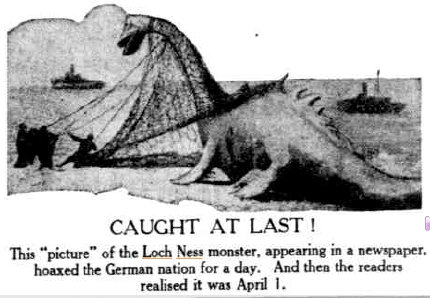
The hero of the hour was Mackeenkool, the intrepid Scottish animal photographer, who actually took a snap of the animal on the shores of the loch, straining in the huge nets which made it a captive. So the news item was
bound to be true.
And next day. Hans and Fitz thought hard and realised it was . . . April 1. The paper had April-fooled them. It was not the Loch Ness monster; only a monster hoax. And that rascal Mackeenkool, whose name was on everyone's lips the day before and whom scores and scores of people had claimed to have met, also developed all the nebulousness of a fictitious character. Like the "captured" monster, he was only a rumor, too.
SEA MONSTERS
Cause Of Sudden "Epidemic"
The Advertiser (Adelaide, SA)
Date: May 25, 1934
Page Number: 26
Ever since the appearance of a gigantic marine creature in the murky depths of Loch Ness in Scotland, monsters of similar type have been reported in other parts of the world. One was washed up on a French beach, and another was seen in Turkish waters.
Scientists explain that the "epidemic" was probably caused by an undersea volcano, which spouted the creatures to the surface. Such a possibility, and entertaining tit-bits about sea monsters, ancient and modern, is the subject of a splendid article in "The Express and Journal," the popular week-end magazine newspaper which is available at 2d.
"Man Overboard" is a thrilling sea story of another type, incidentally explaining why it is that blacks are safer in shark-infested waters than are white men.
...

"Scientists explain that the "epidemic" was probably caused by an undersea volcano, which spouted the creatures to the surface."
Which
scientists have said that???
AUSTRALIAN MUSEUM MAGAZINE
The Sydney Morning Herald (NSW)
Date: June 2, 1934
Page Number: 20
The latest issue of the Museum Magazine maintains the high standard of that quarterly publication. Dr. Anderson, director of the museum, comments upon the "Sea Serpent and its Kind," and refers, incidently, to the "Loch Ness monster."
...

Charles Anderson
(1876-1944)
Museum director
Mineralologist


"DEVIL" OF THE CATARACT
RIVAL TO LOCH NESS MONSTER
Kalgoorlie Miner (WA)
Date: June 5, 1934
Page Number: 2
Meet "the devil" of Devil's Cataract, Southern Rhodesia, the latest rival to that elusive "monster" of Loch Ness.
He is described by Captain J. J. Reynard, curator of the Southern Rhodesian section of the Victoria Falls, where the Devil's Cataract is situated, as a beast 30 feet long, with a small head and a thick, black body.
At least four Europeans living at the falls have seen this monster, Captain Reynard declared while on holiday in Durban, and Mr. Victor Pare, who has lived on the banks of the Zambesi for 13 years, has seen it twice. Mr. Pare has described how he saw "fold after fold" of the monster before it disappeared mysteriously beneath the
water.
"In the minds of the natives," added Captain Reynard, "there is no doubt of the reality of the monster, and it has apparently been a tribal bogey for many generations."

07-04-2014
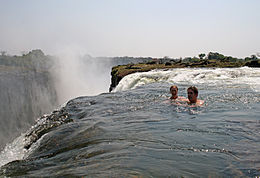

A famous feature is the naturally formed Devil's Pool, near the edge of the falls on Livingstone Island on the Zambian side. When the river flow is at a certain level, usually between September and December, a rock barrier forms an eddy with minimal current, allowing adventurous swimmers to splash around in relative safety a few feet from the point where the water cascades over the falls. Occasional deaths have been reported when people have slipped over the rock barrier.
Joseph James Reynard served in the Rhodesia 1896 campaign as a Trooper in the Umtali Volunteer Corps and in the Mashonaland 1897 campaign as a Trumpeter in the Umtali Volunteers... During the Great War Reynard served with the British South African Police (Southern Rhodesia Column) from October 1915 to January 1917, and also with the East African Transport Corps. Sold with some copied research details.

MONSTER IS PROFITABLE.
Newcastle Morning Herald and Miners' Advocate (NSW)
Date: June 4, 1934
Page Number: 6
The Loch Ness monster is a paying proposition, according to Professor J. Macdonald Holmes, Professor of Geography at Sydney University, who returned to Sydney by the Maunganui on Saturday. When he passed through Loch Ness at Easter, he said, the hotels were crowded. There was something in the lake which needed explaining, he declared. It might be a deformed or large seal. In the early writings of the Pict Kings references were made to a monster in the Loch.
...


Professor James Macdonald Holmes


Realistic Impression Of "Sea Serpent"
The Advertiser (Adelaide, SA)
Date: June 6, 1934
Page Number: 11
Captain Litton, of the cargo vessel King Arthur, which arrived at Thevenard today to load wheat, speaking of his travels, said that on a previous voyage he would have given £10 to have had a camera in his hands when in North Borneo waters on a trip from Dairien to Rotterdam with beans. When standing on the bridge, he and other officers saw what appeared to be a 120-ft. monster, with a whiskery head on a swan-like neck, and an undulating
body. It was, he said, the most realistic impression he had ever seen of a "sea serpent," and it caused consternation on board. On steering the ship within 200 ft. of it, the object proved to be a floating log of a peculiar undulating shape. Captain Litton said a photo of this would pass anywhere for a companion to the Loch Ness monster.
It will be remembered that a district resident recently told the story of a log of wood resembling in shape a "sea serpent" which had been cast up on the West Coast some years ago. It is thought probable that similar logs
floating in the sea may be responsible for other "sea serpent" stories.

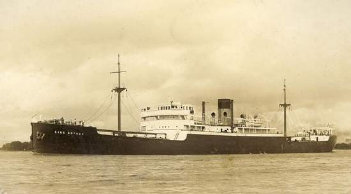
Don Bradman Week
Referee (Sydney, NSW)
Date: June 7, 1934
Page Number: 12
...But listen to Mr. Cardus after he has seen Bradman bat at Worcester on the first day.
"When Bradman emerged from the pavilion the excitement was terrific; he might have been the Loch Ness Monster. Men gulped down their drinks and fled to the scene of action. Bradman opened shakily; he looked curiously slender and somewhat wistful. After the tea interval Bradman settled down; he announced his mastery by an on-drive more crashing and militant and beautiful than any on-drive I have seen since I last looked at him...



Donald Bradman

Sir John Frederick Neville Cardus, CBE (3 April 1888 – 28 February 1975) was an English writer
and critic. From an impoverished
home background, and mainly self-educated, he became cricket
correspondent of The Manchester Guardian in 1919.
This is not the first time that interest in Bradman's was compared to that
17-07-2015


































